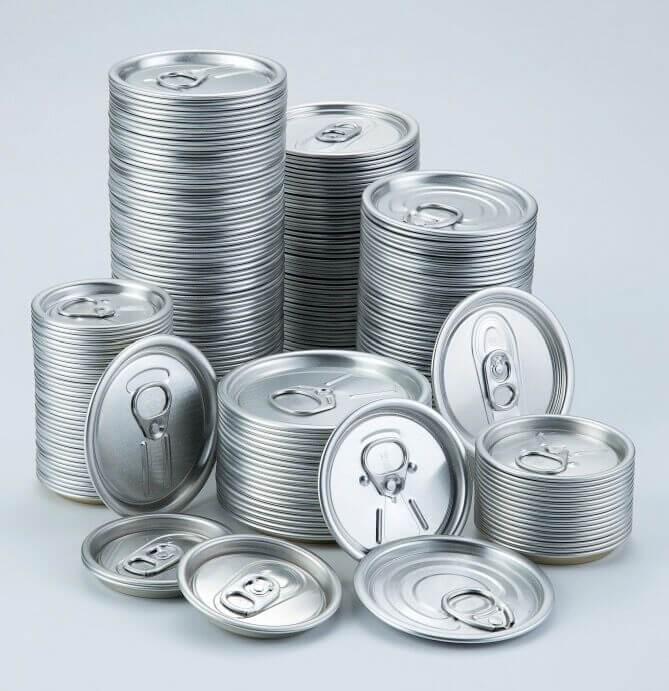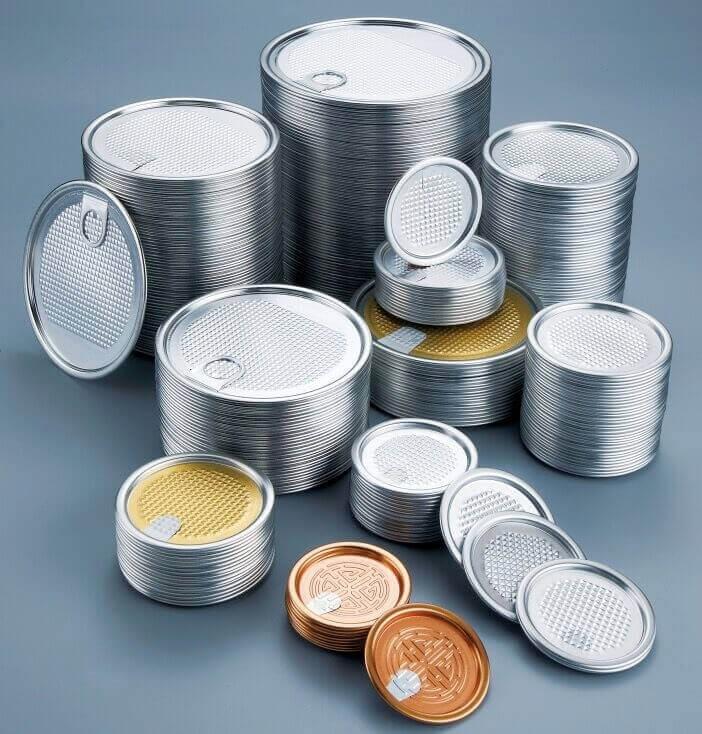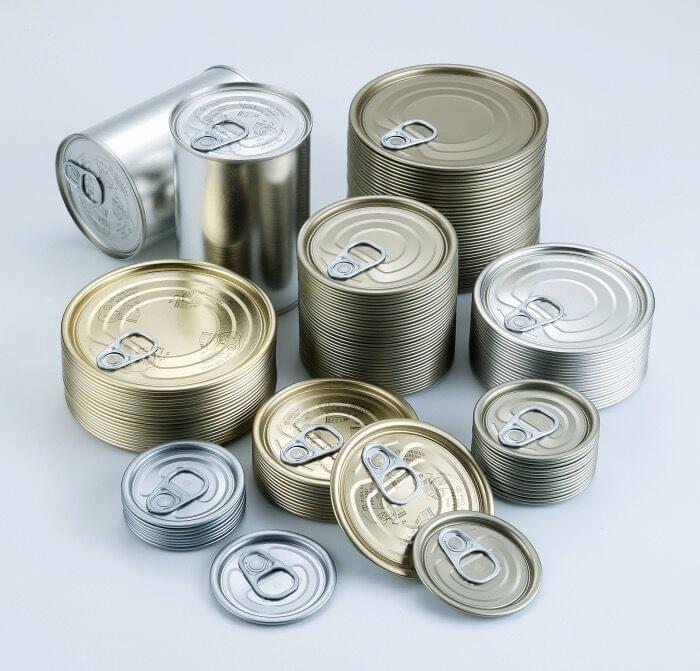
Aluminum and Tinplate can ends, EOE, SOT, RPT, POE, FA for food and beverage

The material is aluminum or tinplate
Peel Off End (POE): Features a lid that can be peeled off completely, providing full access to the contents. POEs are commonly used in products like canned fruits and pet food.
Stay-On-Tab (SOT): Includes a tab that remains attached to the lid after opening, enhancing convenience and reducing litter.
Full Aperture (FA): Provides a wide opening for easy pouring or scooping of products such as sauces, soups, or condiments.

SOT, RPT, FA, B64, CDL, ISE ends
Aluminum can ends are pivotal components in the packaging industry, playing a crucial role in preserving the freshness, convenience, and safety of various beverages and food products. This comprehensive guide delves into the different types of aluminum can ends—Stay-On-Tab (SOT), Riveted Pinch Tab (RPT), and Full Aperture (FA)—highlighting their features, applications, and impact on the packaging landscape.

Peel Off End (POE) (O/D)
Peel off ends (POEs) represent a significant innovation in the realm of packaging solutions, providing consumers with easy access to the contents of cans while ensuring the freshness and integrity of the packaged products. This comprehensive guide delves into the intricacies of peel off ends, highlighting their construction, benefits, diverse applications across industries, and their role in enhancing consumer convenience and satisfaction.

Food Easy Open End
Food easy open ends, often abbreviated as EOEs, are specialized closures designed to facilitate effortless access to canned food products. These innovative lids are engineered to provide a secure seal while enabling consumers to open the can easily without the need for additional tools. EOEs are meticulously crafted from materials like aluminum or tinplate, chosen for their durability, recyclability, and ability to preserve the freshness and nutritional value of packaged foods
Get A Fast Quotation Today!
Welcome to contact us for support, E-catalog and price list of easy open ends
Easy Open Ends for Food and Beverage
Aluminum and Tinplate can ends, EOE, SOT, RPT, POE, FA for food and beverage
Enhancing Convenience and Accessibility with Easy Open Ends in Packaging
In the realm of modern packaging solutions, Easy Open Ends (EOEs) represent a significant innovation that bridges convenience with functionality. These specialized closures have revolutionized how consumers interact with canned food and beverage products, offering ease of access while maintaining the freshness and integrity of the contents. Let's delve into the world of EOEs, exploring their materials, applications, and the benefits they bring to both manufacturers and consumers.
Understanding Easy Open Ends
Easy Open Ends, often referred to as EOEs, are the lids or closures used on cans and containers to facilitate effortless opening. They are engineered with various opening mechanisms such as pull tabs, stay-on-tabs (SOT), peel off ends (POE), and full aperture (FA) designs, catering to different consumer preferences and product types. EOEs are predominantly made from materials like aluminum and tinplate, chosen for their durability, recyclability, and ability to protect the contents from external elements.
Materials Used in Easy Open Ends
Aluminum: Renowned for its lightweight properties and resistance to corrosion, aluminum is a popular choice for EOEs in beverage packaging. It helps preserve the taste and quality of beverages while ensuring the lid remains intact and easy to open.
Tinplate: Known for its strength and ability to form a protective barrier, tinplate is often used in EOEs for canned food products. It safeguards the contents against moisture and other contaminants, maintaining their freshness and nutritional value.
The selection of materials for EOEs is critical as they play a pivotal role in preserving product quality and extending shelf life, all while meeting stringent safety and regulatory standards.
Applications Across Food and Beverage Industries
Easy Open Ends find widespread application across various sectors within the food and beverage industries:
Food Industry: EOEs are indispensable in packaging canned foods such as soups, vegetables, fruits, and ready-to-eat meals. They ensure easy access to the contents while preserving flavor and nutritional integrity.
Beverage Industry: In beverages, EOEs are used for sealing carbonated drinks, juices, energy drinks, and other liquid refreshments. They maintain carbonation levels and prevent contamination, ensuring a consistent taste experience for consumers.
Different types of EOEs cater to specific needs and consumer preferences:
Peel Off End (POE): Features a lid that can be peeled off completely, providing full access to the contents. POEs are commonly used in products like canned fruits and pet food.
Stay-On-Tab (SOT): Includes a tab that remains attached to the lid after opening, enhancing convenience and reducing litter.
Full Aperture (FA): Provides a wide opening for easy pouring or scooping of products such as sauces, soups, or condiments.
Each type of EOE is designed to optimize user experience while ensuring product safety and freshness.
Advantages of Easy Open Ends
Easy Open Ends offer several advantages that contribute to their popularity and widespread adoption in the packaging industry:
Convenience: They simplify the process of opening cans, eliminating the need for additional tools and reducing consumer frustration.
Preservation: EOEs create a secure seal that protects against moisture, oxygen, and light, thereby preserving the freshness and quality of the contents.
Safety and Hygiene: Incorporating tamper-evident features, EOEs enhance product safety by providing visible indicators of tampering or contamination.
Sustainability and Recyclability
In an era where environmental sustainability is paramount, EOEs made from aluminum and tinplate are highly recyclable. This supports circular economy principles by reducing waste and conserving natural resources. Manufacturers are increasingly focusing on sustainable practices, including the use of recycled materials and minimizing environmental impact throughout the lifecycle of EOEs.
Future Trends and Innovations
Looking ahead, the evolution of Easy Open Ends is poised to continue with advancements in technology and consumer-centric designs:
Smart Packaging Integration: Integration of smart technologies to enhance product traceability, freshness monitoring, and consumer engagement.
Biodegradable Materials: Research and development efforts are exploring biodegradable alternatives for EOEs, aligning with global sustainability goals.
Customization and Personalization: Increasing demand for personalized packaging solutions that cater to specific consumer preferences and market trends.
In conclusion, Easy Open Ends represents a cornerstone of modern packaging innovation, combining convenience, functionality, and sustainability in the food and beverage sectors. Their evolution continues to shape consumer expectations and industry standards, driving towards enhanced user experiences and environmental stewardship. As technologies and materials evolve, EOEs will remain pivotal in ensuring that packaged products reach consumers in optimal condition, ready to be enjoyed with convenience and peace of mind.
About Us
We are a trusted supplier of beer, food and beverage packaging and machines. We only use high qualified raw materials. Welcome to join us to be our agents all over the world.
Contact Us
Yantai Trano Beer Keg and Machines
Email: director@
Phone:+86 13054501345
Whatsapp: +86 13054501345
Wechat 13054501345
Web: www.sskeg.com




